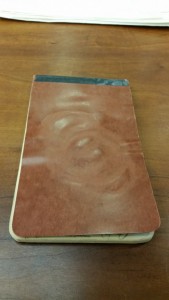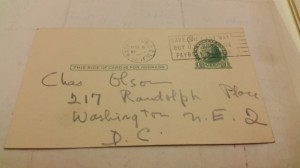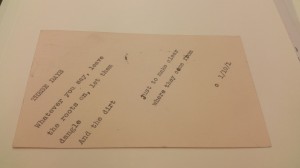by Casie Trotter, MA student in English Literature at the University of Tulsa, Oklahoma, and awardee of Archives and Special Collections’ Strochlitz Travel Grant.
For someone like the poet Charles Olson, visiting an archive is very important. He was all about the “record,” the “document”—two words he often used in and about his own work. It’s not surprising, then, that he preserved much of his life, from personal notebooks to ongoing iterations of new poems and essays. Thousands of letters from people as diverse as his parents, lovers, William Carlos Williams, John Huston, and Carl Jung remain in his files.
 I know because thanks to the generosity of Archives and Special Collections and a Strochlitz Travel Grant, I got to spend a week there early this spring, exploring the depths of the Charles Olson Research Collection. Five days was enough to see over eighty unpublished poems, about seventy prose pieces, hundreds of letters, a dozen notebooks and journals, and several books from his personal library. These were only a fraction of the wealth of Olson materials in the Thomas J. Dodd Research Center, but it was more than enough to strengthen my ongoing research. The archive’s tangible nature enabled me to witness Olson’s creative process on a whole new level. Bottle rings stood out on his leather notebooks; cigarette burns dotted his manuscripts. Sometimes I found letter drafts on the backs of other pieces, whether to the Gas Company or T.S. Eliot.
I know because thanks to the generosity of Archives and Special Collections and a Strochlitz Travel Grant, I got to spend a week there early this spring, exploring the depths of the Charles Olson Research Collection. Five days was enough to see over eighty unpublished poems, about seventy prose pieces, hundreds of letters, a dozen notebooks and journals, and several books from his personal library. These were only a fraction of the wealth of Olson materials in the Thomas J. Dodd Research Center, but it was more than enough to strengthen my ongoing research. The archive’s tangible nature enabled me to witness Olson’s creative process on a whole new level. Bottle rings stood out on his leather notebooks; cigarette burns dotted his manuscripts. Sometimes I found letter drafts on the backs of other pieces, whether to the Gas Company or T.S. Eliot.
In the process, I uncovered plenty of links to themes and ideas in Olson’s work I’d already been tracing. My MA project at the University of Tulsa developed over the course of two years—starting as a love affair with The Maximus Poems duringmy first semester as a grad student and culminating in this trip to Connecticut a month before graduation. What began as a critical analysis of Olson’s pre-Maximus life and work, an attempt to construct a theoretical framework that led to his Gloucester epic, turned into a very personal journey as I found his ideas and experiences increasingly relevant to mine too. His conflicted relationship with academia mirrored my own; his open and visceral love for the world and who shaped it found a home in the ways I interact with other people. These connections made the project important not only for my academic career, but also gave it larger dimensions that could translate into other parts of my life.
When not in the reading room, then, I also visited Worcester (Olson’s hometown) in nearby Massachusetts and Middletown (where Olson attended Wesleyan). UCONN’s proximity to these locations made it easy to expand the trip into an even more immersive experience. The side tours were particularly valuable ways to encounter the spirit of Olson’s world(s) on some level. Driving through Worcester, sea gulls flew overhead; a Catholic church loomed over the street where newer three-story flats have replaced the one where he grew up. Around Wesleyan, neighborhoods and small businesses evoked a sense of place unique to their environment. This part of the research process was not only how I think Olson would want his work and life to be studied—a poet rooted deeply in the local, the concrete—but helped further tie me to the primary aspects of what it was like to be Charles Olson, almost as meaningfully as the direct experience of the archive itself. I’d been absorbed in his work for so long that feeling my way through his stomping grounds came naturally and powerfully. The commute between campus and my hotel through rural areas provided further reflective avenues for understanding the writer’s world and the backdrop to many of his words that have been the ongoing soundtrack to my grad school years.
The catalyst for my project was discovering Olson’s complicated paternal relationship with Ezra Pound in the aftermath of WWII and EP’s treason trial. Within weeks after Pound was committed to St. Elizabeths Hospital, the younger poet started visiting the elder and providing a source of encouragement. For two and a half years, Pound was another “Papa” in his life. Olson carried drafts of the Pisan Cantos between Pound and his publisher, James Laughlin. Between visits, they corresponded back and forth. The Collection at the Dodd Research Center includes about two dozen postcards from Pound to Olson, among other fragments and pieces the young poet wrote while trying to make sense of a fascist genius. He struggled to understand how someone who could write such beautiful, innovative poetry could also perpetuate such hate-filled ideas.
Although Catherine Seelye edited and published materials from Olson’s “Pound File” at Storrs several decades ago (another great use of their Collection), reading this compilation in paperback form could not compare to observing the pieces firsthand. Seelye’s book made me want to know everything about Olson, to piece together all the people and moments that built him into the giant he was (literally and figuratively). Pound was so crucial to his developing conception of what it means to be a poet that he was the ideal place to start. By the time I got to Connecticut, I’d read all of the Cantos, the Maximus Poems, and spent six months actively compiling and consuming everything else Olson had written before his epic (the Storrs Collection’s unpublished materials also gave me a lot more to work with). While I didn’t get to read everything with equal attention, I’d built enough of a foundation to understand what Olson was capable of and to better appreciate how significant his connections to earlier figures were. And I’d become attached enough to him that he had carried me through some very difficult personal experiences as I was trying to figure out how to “love the world and stay inside it” as he later said in Maximus.
 So when I opened the folder with Pound’s postcards, it took a conscious effort not to let my misty eyes drip onto his penciled signature. Since most other scholars (including Seelye) have prioritized Olson’s own words about Pound over what Pound actually wrote to him, these cards were almost like experiencing another world in their relationship. Having studied Olson’s reflections on their frustrated interactions, I was able to reenact his process through each note and gain a better sense of how his feelings were being influenced at the time. Digging through the correspondence files, I unearthed the initial telegram from Olson’s early publisher, Dorothy Norman, asking him to cover Pound’s trial in Washington, and the letter from Laughlin encouraging the young writer to visit his client in the first place. Laughlin also later sent and inscribed a hardcover of the Pisan Cantos to Olson, which remains in his personal library at Storrs. In his WWII-era notebooks, I found his early (unpublished) writings about Pound as the controversy unfolded. But the most heartbreaking postcard was written a few months after Olson stopped visiting Pound in 1948, too weary of the old poet’s racism and closed-mindedness. Wanting to know where he’d gone, EP wrote, “Yes my deah [sic] Charles I just [wonder] wot [sic] are you up to O[?]”. Olson wouldn’t see Pound again for about fifteen years, so this postcard didn’t soften him too much—but I can imagine the effect it still must have had on him after how much energy and affection he’d invested in Pound during some of Olson’s most formative years as a writer.
So when I opened the folder with Pound’s postcards, it took a conscious effort not to let my misty eyes drip onto his penciled signature. Since most other scholars (including Seelye) have prioritized Olson’s own words about Pound over what Pound actually wrote to him, these cards were almost like experiencing another world in their relationship. Having studied Olson’s reflections on their frustrated interactions, I was able to reenact his process through each note and gain a better sense of how his feelings were being influenced at the time. Digging through the correspondence files, I unearthed the initial telegram from Olson’s early publisher, Dorothy Norman, asking him to cover Pound’s trial in Washington, and the letter from Laughlin encouraging the young writer to visit his client in the first place. Laughlin also later sent and inscribed a hardcover of the Pisan Cantos to Olson, which remains in his personal library at Storrs. In his WWII-era notebooks, I found his early (unpublished) writings about Pound as the controversy unfolded. But the most heartbreaking postcard was written a few months after Olson stopped visiting Pound in 1948, too weary of the old poet’s racism and closed-mindedness. Wanting to know where he’d gone, EP wrote, “Yes my deah [sic] Charles I just [wonder] wot [sic] are you up to O[?]”. Olson wouldn’t see Pound again for about fifteen years, so this postcard didn’t soften him too much—but I can imagine the effect it still must have had on him after how much energy and affection he’d invested in Pound during some of Olson’s most formative years as a writer.
In this respect, spending time at the Dodd Research Center was extremely fruitful, both in terms of research and my ever-more intimate connection to a writer who must be studied through primary documents and an empathetic point of view. To do a person like Charles Olson justice requires closer attention than someone without the primal experience of an archive can give. At this point, I may still be working through how my own work will speak for him in the future, but I know that it needed a pilgrimage like this trip to give it firm roots to cling to.

